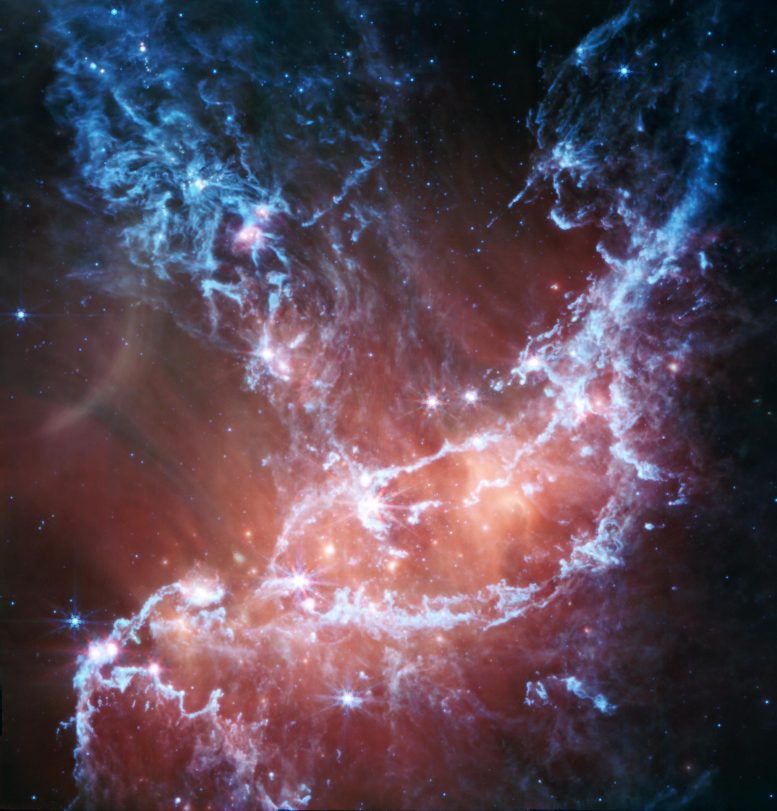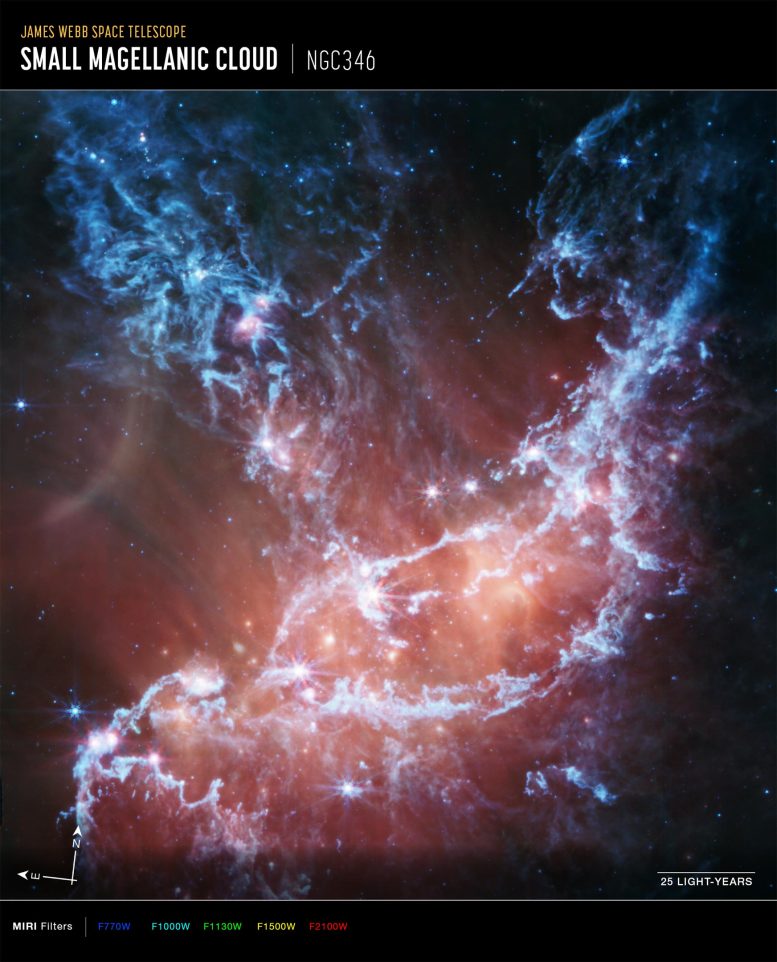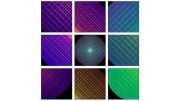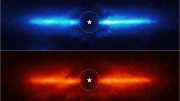
This new infrared image of NGC 346 from NASA’s James Webb Space Telescope’s Mid-Infrared Instrument (MIRI) traces emissions from cool gas and dust. In this image blue represents silicates and sooty chemical molecules known as polycyclic aromatic hydrocarbons, or PAHs. More diffuse red emission shines from warm dust heated by the brightest and most massive stars in the heart of the region. Bright patches and filaments mark areas with abundant numbers of protostars. Credit: NASA, ESA, CSA, STScI, Nolan Habel (NASA-JPL), Patrick Kavanagh (Maynooth University)
Filaments of Dust and Gas Festoon This Star-Forming Region in a New Infrared Image From MIRI
Within a neighboring dwarf galaxy known as the Small Magellanic Cloud (SMC) lies a dramatic region of star birth – NGC 346, shown here. As the brightest and largest star-forming region in the SMC, it has been studied intensely by a variety of telescopes. NASA’s Hubble Space Telescope showed a visible-light view filled with thousands of stars. More recently, NASA’s James Webb Space Telescope offered a near-infrared vista highlighting both cool and warm dust. Now, Webb has turned its mid-infrared gaze to NGC 346, revealing streamers of gas and dust studded with bright patches filled with young protostars.
This video compares images of star-forming region NGC 346 taken in visible light with the Hubble Space Telescope’s ACS instrument, near-infrared with the James Webb Space Telescope’s NIRCam instrument, and mid-infrared with Webb’s MIRI instrument. Hubble’s visible-light image is filled with thousands of stars, as well as curtains of hydrogen and oxygen gas colored blue. In Webb’s near-infrared image, pink represents energized hydrogen, while orange represents dense, molecular hydrogen. Webb’s mid-infrared image highlights bright patches of star formation, diffuse pink emission from warm dust, and blue filaments of dusty and sooty material. Credit: NASA, ESA, CSA, Alyssa Pagan (STScI)
NASA’s Webb Space Telescope Captures an Ethereal View of NGC 346
One of the greatest strengths of NASA’s James Webb Space Telescope is its ability to give astronomers detailed views of areas where new stars are being born. The latest example, showcased here in a new image from Webb’s Mid-Infrared Instrument (MIRI), is NGC 346 – the brightest and largest star-forming region in the Small Magellanic Cloud.
The Small Magellanic Cloud (SMC) is a satellite galaxy of the Milky Way, visible to the unaided eye in the southern constellation Tucana. This small companion galaxy is more primeval than the Milky Way in that it possesses fewer heavy elements, which are forged in stars through nuclear fusion and supernova explosions, compared to our own galaxy.

This image of NGC 346, captured by Webb’s Mid-Infrared Instrument (MIRI), shows compass arrows, scale bar, and color key for reference. The north and east compass arrows show the orientation of the image on the sky. The field of view shown in this image is approximately 150 light-years across. This image shows invisible mid-infrared wavelengths of light that have been translated into visible-light colors. The color key shows which MIRI filters were used when collecting the light. The color of each filter name is the visible light color used to represent the infrared light that passes through that filter. Credit: NASA, ESA, CSA, STScI, Nolan Habel (NASA-JPL), Patrick Kavanagh (Maynooth University)
Since cosmic dust is formed from heavy elements like silicon and oxygen, scientists expected the SMC to lack significant amounts of dust. However, the new MIRI image, as well as a previous image of NGC 346 from Webb’s Near-Infrared Camera released in January, show ample dust within this region.
In this representative-color image, blue tendrils trace emission from material that includes dusty silicates and sooty chemical molecules known as polycyclic aromatic hydrocarbons, or PAHs. More diffuse red emission shines from warm dust heated by the brightest and most massive stars in the heart of the region. An arc at the center left may be a reflection of light from the star near the arc’s center. (Similar, fainter arcs appear associated with stars at lower left and upper right.) Lastly, bright patches and filaments mark areas with abundant numbers of protostars. The research team looked for the reddest stars, and found 1,001 pinpoint sources of light, most of them young stars still embedded in their dusty cocoons.
This zoom-in video shows the relative location of NGC 346 on the sky. It begins with a ground-based photo by the late astrophotographer Akira Fujii. As it zooms into smaller portions of the sky, it fades into an image from the European Southern Observatory’s (ESO) Vista telescope followed by ESO’s La Silla Observatory. It ends by crossfading into an image of NGC 346 from MIRI (the Mid-Infrared Instrument) on NASA’s James Webb Space Telescope. Credit: NASA, ESA, CSA, Alyssa Pagan (STScI), Acknowledgment: ESO, Akira Fujii
By combining Webb data in both the near-infrared and mid-infrared, astronomers are able to take a fuller census of the stars and protostars within this dynamic region. The results have implications for our understanding of galaxies that existed billions of years ago, during an era in the universe known as “cosmic noon,” when star formation was at its peak and heavy element concentrations were lower, as seen in the SMC.
The James Webb Space Telescope is the world’s premier space science observatory. Webb is solving mysteries in our solar system, looking beyond to distant worlds around other stars, and probing the mysterious structures and origins of our universe and our place in it. Webb is an international program led by NASA with its partners, ESA (European Space Agency) and the Canadian Space Agency.









Be the first to comment on "NASA’s Webb Reveals Breathtaking Glimpse of Star Birth in Ethereal Depths"